Objective 1. Insert and Modify Clip Art and Pictures
Graphic images can be inserted into a document from many sources. A clip is a media file, including art, sound, animation, or movies. Recall that clip art images are predefined graphic images that can be inserted from files provided with Microsoft Office or downloaded from the Microsoft Office Web site. Pictures can be scanned from photographs or slides, taken with a digital camera, or downloaded from the Web.
Activity 3.1. Inserting Clip Art
|
1. |
Start Word. On the Standard toolbar, click the New button |
|
2. |
From the File menu, display the Page Setup dialog box, and then change the Left margin to 1" and the Right margin to 1". Click OK. |
|
3. |
Click the Center button |
|
4. |
Position the insertion point in the fourth (blank) line. From the Insert menu, click File. Navigate to the location where the student files for this textbook are stored and insert w03A_Job_Opportunities. Press Figure 3.2. 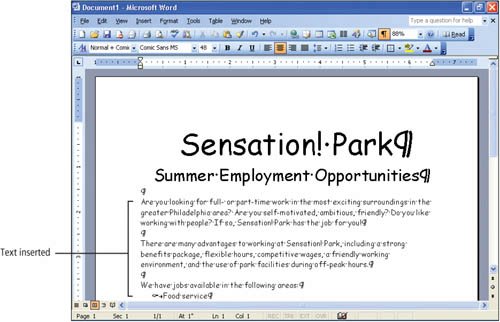
|
|
5. |
Display the Save As dialog box. Navigate to the location where you are storing your projects, and then create a new folder named Word Chapter 3 and click OK. Save the file as 3A_Job_Opportunities_Firstname_Lastname |
|
6. |
In the paragraph near the top of the document beginning Are you looking, click to place the insertion point to the left of the first word in the paragraph. From the Insert menu, point to Picture, and then click Clip Art to display the Clip Art task pane. |
|
7. |
In the Clip Art task pane, click the Search in arrow; if necessary, select the Everywhere check box, then click the Search in arrow again and verify that All collections displays. Click the Results should be arrow; if necessary, select the All media types check box, then click the Results should be arrow again and verify that All media file types displays. |
|
|
|
|
8. |
In the Search for box, delete any existing text, type roller coaster and then click the Go button. Locate the roller coaster image from the task pane as shown in Figure 3.3. Use the scroll bar if necessary. Figure 3.3. 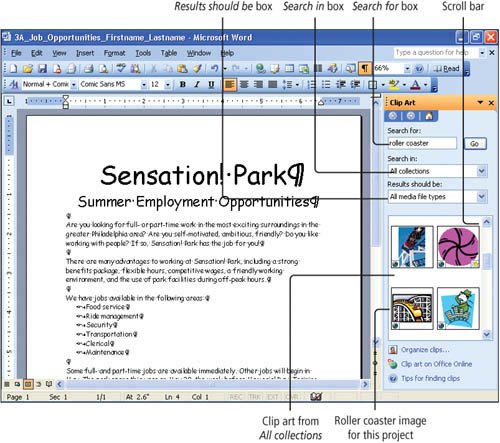
Alert!: Is the Image Missing from Your Task Pane? If the appropriate image is not displayed on your task pane, display the Insert menu, point to Picture, click From File, navigate to the student files that accompany this textbook, click w03A_Roller_Coaster, and then click the Insert button. Alternatively, use a similar image from the task pane. Your college lab may have a limited number of clip art images installed. Word searches the hard drive and also attempts to access the clip art libraries on the Microsoft Office Web site. If you are not connected to the Web, your screen may not display the images shown in Figure 3.3. |
|
|
|
|
9. |
Click the roller coaster image, Save Figure 3.4. 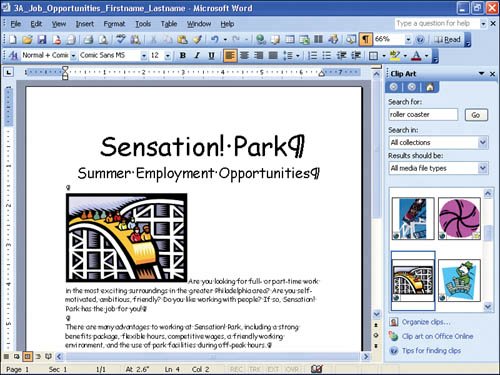
The clip art image is placed at the insertion point location. When images are placed in documents, they are inline images; that is, they are positioned directly in the text at the insertion point, just like characters in a sentence. |
Activity 3.2. Inserting Pictures from Files
Pictures can be added to a document, either by browsing for a picture on a disk drive or by using the Clip Art task pane.
|
1. |
Scroll to view the paragraph beginning There are many advantages, and then click to place the insertion point to the left of the first word in the paragraph. If the task pane is not displayed, from the View menu, click Task Pane. In the Clip Art task pane, in the Search for box, type Ferris wheel Click the Results should be arrow, clear all the check boxes except Photographs. Compare your screen with Figure 3.5. Figure 3.5.
Restricting the media type will limit the number of images found but will be helpful when you are searching for a topic with a large number of images. |
|
2. |
Click the Results should be arrow again to close the list, and then click Go to display Ferris wheel photographs. Click to insert the vertical Ferris wheel image with the dark blue background. If the image is not available, display the Insert menu, point to Picture, click From File, navigate to your student files, click w03A_Ferris_Wheel, and click Insert. Scroll to view the top of the second page. Compare your screen with Figure 3.6. Figure 3.6. (This item is displayed on page 413 in the print version) 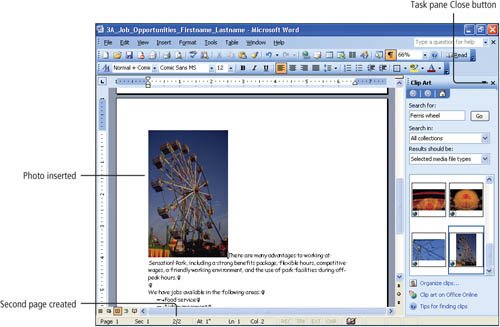
The photograph is inserted at the insertion point location and the document expands to a second page. |
|
|
|
|
3. |
On the Clip Art task pane title bar, click the Close button |
|
4. |
Close |
Activity 3.3. Wrapping Text Around Graphic Objects
Pictures and clip art images inserted as inline images are treated like characters in a sentence. Thus, the result can cause awkward spacing in a document. To avoid this, you can format any graphic to move independently of the surrounding text by changing inline images to floating imagesimages that can be moved independently of the surrounding text. This is accomplished by changing the wrapping options.
|
|
|
|
1. |
Locate and click the first imagethe roller coasterthat you inserted, and then compare your screen with Figure 3.7. Figure 3.7. 
Sizing handles, small black boxes, display around the image border. These handles are used to increase or decrease the size of the image. The sizing handles also indicate that the image is selected. The Picture toolbar may display, either floating over the document or added to the other toolbars. |
|
2. |
From the Format menu, click Picture. Alternatively, right-click the image and click Format Picture from the shortcut menu. In the Format Picture dialog box, click the Layout tab to display the wrapping and alignment options, as shown in Figure 3.8. Figure 3.8. 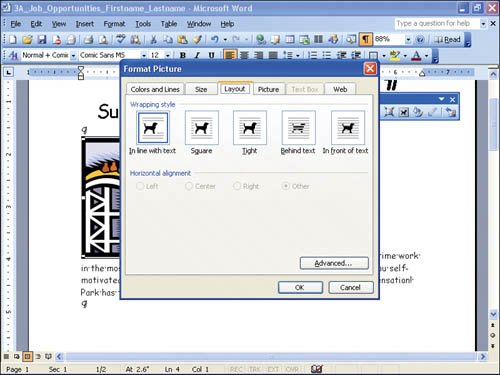
|
|
3. |
Under Wrapping style, click Tight, and then click OK. Compare your screen with Figure 3.9. Figure 3.9. 
|
|
|
|
|
4. |
Scroll down and click the Ferris wheel picture, be sure your pointer is over the picture, and then right-click. From the shortcut menu, click Format Picture, click the Layout tab, and under Wrapping style, click Tight. Click OK. |
|
5. |
Save |
Activity 3.4. Resizing and Moving a Graphic Object
Usually you will want to adjust the size of the clip art and pictures that you place in documents. Use the sizing handles to resize images.
|
1. |
If the Picture toolbar is blocking your view of the horizontal ruler, move the toolbar down and to the left of your screen. Be sure your ruler is displayed; if necessary, from the View menu, click Ruler. Locate and click to select the first image you insertedthe roller coaster. Drag the image to the right side of the page so that its right edge aligns at approximately 6.5 inches on the horizontal ruler. |
||||||||||
|
2. |
Scroll to the left as necessary to see the anchor. Then, take a moment to study the table in Figure 3.10 that describes the purpose of each of these formatting marks. Refer to Figure 3.11 for placement of the image.
Figure 3.11. 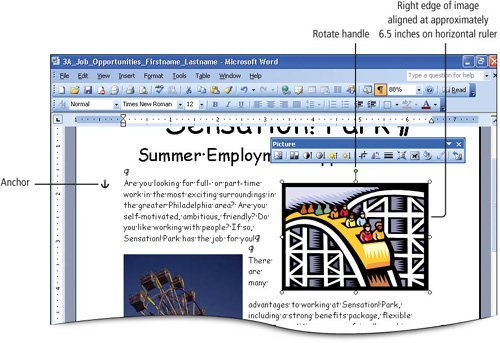
|
||||||||||
|
3. |
Locate the sizing handle in the middle of the lower edge of the roller coaster image and drag it up until the image is about an inch high, which distorts the picture. Use the vertical ruler on the left edge of the screen as a visual guide; however, your measurement need not be precise. Compare your screen with Figure 3.12. Figure 3.12. 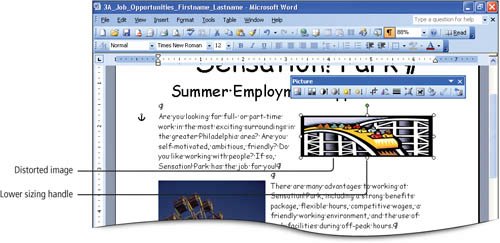
|
||||||||||
|
|
|||||||||||
|
4. |
On the Standard toolbar, click the Undo button Figure 3.13. 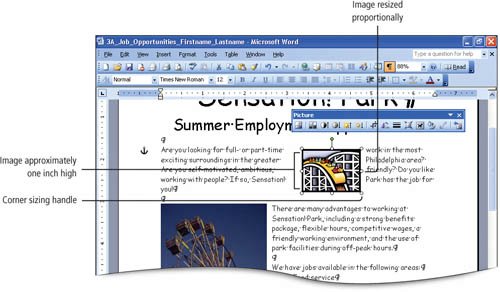
Notice that the image is resized proportionally and not distorted. Do not be concerned if the words do not wrap exactly as shown in Figure 3.13. |
||||||||||
|
5. |
Point to the middle of the roller coaster image but do not click. Figure 3.14. (This item is displayed on page 419 in the print version) 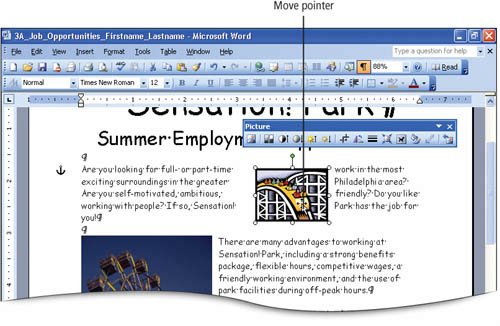
After you have applied one of the image wrapping options to convert the image from an inline image to a floating image, you can move the image anywhere on the page. |
||||||||||
|
|
|||||||||||
|
6. |
Click and then drag the image to the right of the paragraph beginning Are you looking for, until the right edge is aligned at approximately 6.5 inches on the horizontal ruler. To position your picture more precisely, hold down Figure 3.15. 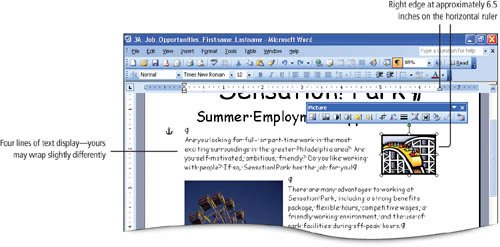
|
||||||||||
|
|
|||||||||||
|
7. |
Click in a blank area to deselect the image and close the Picture toolbar, and then Save |
|
[Page 420 (continued)] Objective 2 Use the Drawing Toolbar |
Windows XP
- Chapter One. Getting Started with Windows XP
- Project 1A. Windows XP
- Objective 1. Get Started with Windows XP
- Objective 2. Resize, Move, and Scroll Windows
- Objective 3. Maximize, Restore, Minimize, and Close a Window
- Objective 4. Create a New Folder
- Objective 5. Copy, Move, Rename, and Delete Files
- Objective 6. Find Files and Folders
- Objective 7. Compress Files
- Summary
- Key Terms
- Concepts Assessments
Outlook 2003
- Chapter One. Getting Started with Outlook 2003
- Getting Started with Microsoft Office Outlook 2003
- Project 1A. Exploring Outlook 2003
- Objective 1. Start and Navigate Outlook
- Objective 2. Read and Respond to E-mail
- Objective 3. Store Contact and Task Information
- Objective 4. Work with the Calendar
- Objective 5. Delete Outlook Information and Close Outlook
- Summary
- Key Terms
- Concepts Assessments
- Skill Assessments
- Performance Assessments
- Mastery Assessments
- Problem Solving
- GO! with Help
Internet Explorer
- Chapter One. Getting Started with Internet Explorer
- Getting Started with Internet Explorer 6.0
- Project 1A. College and Career Information
- Objective 1. Start Internet Explorer and Identify Screen Elements
- Objective 2. Navigate the Internet
- Objective 3. Create and Manage Favorites
- Objective 4. Search the Internet
- Objective 5. Save and Print Web Pages
- Summary
- Key Terms
- Concepts Assessments
- Skill Assessments
- Performance Assessments
- Mastery Assessments
- Problem Solving
Computer Concepts
- Chapter One. Basic Computer Concepts
- Objective 1. Define Computer and Identify the Four Basic Computing Functions
- Objective 2. Identify the Different Types of Computers
- Objective 3. Describe Hardware Devices and Their Uses
- Objective 4. Identify Types of Software and Their Uses
- Objective 5. Describe Networks and Define Network Terms
- Objective 6. Identify Safe Computing Practices
- Summary
- In this Chapter You Learned How to
- Key Terms
- Concepts Assessments
Word 2003
Chapter One. Creating Documents with Microsoft Word 2003
- Chapter One. Creating Documents with Microsoft Word 2003
- Getting Started with Microsoft Office Word 2003
- Project 1A. Thank You Letter
- Objective 1. Create and Save a New Document
- Objective 2. Edit Text
- Objective 3. Select, Delete, and Format Text
- Objective 4. Create Footers and Print Documents
- Project 1B. Party Themes
- Objective 5. Navigate the Word Window
- Objective 6. Add a Graphic to a Document
- Objective 7. Use the Spelling and Grammar Checker
- Objective 8. Preview and Print Documents, Close a Document, and Close Word
- Objective 9. Use the Microsoft Help System
- Summary
- Key Terms
- Concepts Assessments
- Skill Assessments
- Performance Assessments
- Mastery Assessments
- Problem Solving
- You and GO!
- Business Running Case
- GO! with Help
Chapter Two. Formatting and Organizing Text
- Formatting and Organizing Text
- Project 2A. Alaska Trip
- Objective 1. Change Document and Paragraph Layout
- Objective 2. Change and Reorganize Text
- Objective 3. Create and Modify Lists
- Project 2B. Research Paper
- Objective 4. Insert and Format Headers and Footers
- Objective 5. Insert Frequently Used Text
- Objective 6. Insert and Format References
- Summary
- Key Terms
- Concepts Assessments
- Skill Assessments
- Performance Assessments
- Mastery Assessments
- Problem Solving
- You and GO!
- Business Running Case
- GO! with Help
Chapter Three. Using Graphics and Tables
- Using Graphics and Tables
- Project 3A. Job Opportunities
- Objective 1. Insert and Modify Clip Art and Pictures
- Objective 2. Use the Drawing Toolbar
- Project 3B. Park Changes
- Objective 3. Set Tab Stops
- Objective 4. Create a Table
- Objective 5. Format a Table
- Objective 6. Create a Table from Existing Text
- Summary
- Key Terms
- Concepts Assessments
- Skill Assessments
- Performance Assessments
- Mastery Assessments
- Problem Solving
- You and GO!
- Business Running Case
- GO! with Help
Chapter Four. Using Special Document Formats, Columns, and Mail Merge
- Using Special Document Formats, Columns, and Mail Merge
- Project 4A. Garden Newsletter
- Objective 1. Create a Decorative Title
- Objective 2. Create Multicolumn Documents
- Objective 3. Add Special Paragraph Formatting
- Objective 4. Use Special Character Formats
- Project 4B. Water Matters
- Objective 5. Insert Hyperlinks
- Objective 6. Preview and Save a Document as a Web Page
- Project 4C. Recreation Ideas
- Objective 7. Locate Supporting Information
- Objective 8. Find Objects with the Select Browse Object Button
- Project 4D. Mailing Labels
- Objective 9. Create Labels Using the Mail Merge Wizard
- Summary
- Key Terms
- Concepts Assessments
- Skill Assessments
- Performance Assessments
- Mastery Assessments
- Problem Solving
- You and GO!
- Business Running Case
- GO! with Help
Excel 2003
Chapter One. Creating a Worksheet and Charting Data
- Creating a Worksheet and Charting Data
- Project 1A. Tableware
- Objective 1. Start Excel and Navigate a Workbook
- Objective 2. Select Parts of a Worksheet
- Objective 3. Enter and Edit Data in a Worksheet
- Objective 4. Construct a Formula and Use the Sum Function
- Objective 5. Format Data and Cells
- Objective 6. Chart Data
- Objective 7. Annotate a Chart
- Objective 8. Prepare a Worksheet for Printing
- Objective 9. Use the Excel Help System
- Project 1B. Gas Usage
- Objective 10. Open and Save an Existing Workbook
- Objective 11. Navigate and Rename Worksheets
- Objective 12. Enter Dates and Clear Formats
- Objective 13. Use a Summary Sheet
- Objective 14. Format Worksheets in a Workbook
- Summary
- Key Terms
- Concepts Assessments
- Skill Assessments
- Performance Assessments
- Mastery Assessments
- Problem Solving
- You and GO!
- Business Running Case
- GO! with Help
Chapter Two. Designing Effective Worksheets
- Designing Effective Worksheets
- Project 2A. Staff Schedule
- Objective 1. Use AutoFill to Fill a Pattern of Column and Row Titles
- Objective 2. Copy Text Using the Fill Handle
- Objective 3. Use AutoFormat
- Objective 4. View, Scroll, and Print Large Worksheets
- Project 2B. Inventory Value
- Objective 5. Design a Worksheet
- Objective 6. Copy Formulas
- Objective 7. Format Percents, Move Formulas, and Wrap Text
- Objective 8. Make Comparisons Using a Pie Chart
- Objective 9. Print a Chart on a Separate Worksheet
- Project 2C. Population Growth
- Objective 10. Design a Worksheet for What-If Analysis
- Objective 11. Perform What-If Analysis
- Objective 12. Compare Data with a Line Chart
- Summary
- Key Terms
- Concepts Assessments
- Skill Assessments
- Performance Assessments
- Mastery Assessments
- Problem Solving
- You and GO!
- Business Running Case
- GO! with Help
Chapter Three. Using Functions and Data Tables
- Using Functions and Data Tables
- Project 3A. Geography Lecture
- Objective 1. Use SUM, AVERAGE, MIN, and MAX Functions
- Objective 2. Use a Chart to Make Comparisons
- Project 3B. Lab Supervisors
- Objective 3. Use COUNTIF and IF Functions, and Apply Conditional Formatting
- Objective 4. Use a Date Function
- Project 3C. Loan Payment
- Objective 5. Use Financial Functions
- Objective 6. Use Goal Seek
- Objective 7. Create a Data Table
- Summary
- Key Terms
- Concepts Assessments
- Skill Assessments
- Performance Assessments
- Mastery Assessments
- Problem Solving
- You and GO!
- Business Running Case
- GO! with Help
Access 2003
Chapter One. Getting Started with Access Databases and Tables
- Getting Started with Access Databases and Tables
- Project 1A. Academic Departments
- Objective 1. Rename a Database
- Objective 2. Start Access, Open an Existing Database, and View Database Objects
- Project 1B. Fundraising
- Objective 3. Create a New Database
- Objective 4. Create a New Table
- Objective 5. Add Records to a Table
- Objective 6. Modify the Table Design
- Objective 7. Create Table Relationships
- Objective 8. Find and Edit Records in a Table
- Objective 9. Print a Table
- Objective 10. Close and Save a Database
- Objective 11. Use the Access Help System
- Summary
- Key Terms
- Concepts Assessments
- Skill Assessments
- Performance Assessments
- Mastery Assessments
- Problem Solving Assessments
- Problem Solving
- You and GO!
- Business Running Case
- GO! with Help
Chapter Two. Sort, Filter, and Query a Database
- Sort, Filter, and Query a Database
- Project 2A. Club Fundraiser
- Objective 1. Sort Records
- Objective 2. Filter Records
- Objective 3. Create a Select Query
- Objective 4. Open and Edit an Existing Query
- Objective 5. Sort Data in a Query
- Objective 6. Specify Text Criteria in a Query
- Objective 7. Print a Query
- Objective 8. Specify Numeric Criteria in a Query
- Objective 9. Use Compound Criteria
- Objective 10. Create a Query Based on More Than One Table
- Objective 11. Use Wildcards in a Query
- Objective 12. Use Calculated Fields in a Query
- Objective 13. Group Data and Calculate Statistics in a Query
- Summary
- Key Terms
- Concepts Assessments
- Skill Assessments
- Performance Assessments
- Mastery Assessments
- Problem Solving
- You and GO!
- Business Running Case
- GO! with Access Help
Chapter Three. Forms and Reports
- Forms and Reports
- Project 3A. Fundraiser
- Objective 1. Create an AutoForm
- Objective 2. Use a Form to Add and Delete Records
- Objective 3. Create a Form Using the Form Wizard
- Objective 4. Modify a Form
- Objective 5. Create an AutoReport
- Objective 6. Create a Report Using the Report Wizard
- Objective 7. Modify the Design of a Report
- Objective 8. Print a Report and Keep Data Together
- Summary
- Key Terms
- Concepts Assessments
- Skill Assessments
- Performance Assessments
- Mastery Assessments
- Problem Solving
- You and GO!
- Business Running Case
- GO! with Help
Powerpoint 2003
Chapter One. Getting Started with PowerPoint 2003
- Getting Started with PowerPoint 2003
- Project 1A. Expansion
- Objective 1. Start and Exit PowerPoint
- Objective 2. Edit a Presentation Using the Outline/Slides Pane
- Objective 3. Format and Edit a Presentation Using the Slide Pane
- Objective 4. View and Edit a Presentation in Slide Sorter View
- Objective 5. View a Slide Show
- Objective 6. Create Headers and Footers
- Objective 7. Print a Presentation
- Objective 8. Use PowerPoint Help
- Summary
- Key Terms
- Concepts Assessments
- Skill Assessments
- Performance Assessments
- Mastery Assessments
- Problem Solving
- You and GO!
- Business Running Case
- GO! with Help
Chapter Two. Creating a Presentation
- Creating a Presentation
- Project 2A. Teenagers
- Objective 1. Create a Presentation
- Objective 2. Modify Slides
- Project 2B. History
- Objective 3. Create a Presentation Using a Design Template
- Objective 4. Import Text from Word
- Objective 5. Move and Copy Text
- Summary
- Key Terms
- Concepts Assessments
- Skill Assessments
- Performance Assessments
- Mastery Assessments
- Problem Solving
- You and GO!
- Business Running Case
- GO! with Help
Chapter Three. Formatting a Presentation
- Project 3A. Emergency
- Objective 1. Format Slide Text
- Objective 2. Modify Placeholders
- Objective 3. Modify Slide Master Elements
- Objective 4. Insert Clip Art
- Project 3B. Volunteers
- Objective 5. Apply Bullets and Numbering
- Objective 6. Customize a Color Scheme
- Objective 7. Modify the Slide Background
- Objective 8. Apply an Animation Scheme
- Summary
- Key Terms
- Concepts Assessments
- Skill Assessments
- Performance Assessments
- Mastery Assessments
- Problem Solving
- You and GO!
- Business Running Case
- GO! with Help
Integrated Projects
Chapter One. Using Access Data with Other Office Applications
- Chapter One. Using Access Data with Other Office Applications
- Introduction
- Project 1A. Meeting Slides
- Objective 1. Export Access Data to Excel
- Objective 2. Create a Formula in Excel
- Objective 3. Create a Chart in Excel
- Objective 4. Copy Access Data into a Word Document
- Objective 5. Copy Excel Data into a Word Document
- Objective 6. Insert an Excel Chart into a PowerPoint Presentation
Chapter Two. Using Tables in Word and Excel
- Chapter Two. Using Tables in Word and Excel
- Introduction
- Project 2A. Meeting Notes
- Objective 1. Plan a Table in Word
- Objective 2. Enter Data and Format a Table in Word
- Objective 3. Create a Table in Word from Excel Data
- Objective 4. Create Excel Worksheet Data from a Word Table
Chapter Three. Using Excel as a Data Source in a Mail Merge
- Chapter Three. Using Excel as a Data Source in a Mail Merge
- Introduction
- Project 3A. Mailing Labels
- Objective 1. Prepare a Mail Merge Document as Mailing Labels
- Objective 2. Choose an Excel Worksheet as a Data Source
- Objective 3. Produce and Save Merged Mailing Labels
- Objective 4. Open a Saved Main Document for Mail Merge
Chapter Four. Linking Data in Office Documents
- Chapter Four. Linking Data in Office Documents
- Introduction
- Project 4A. Weekly Sales
- Objective 1. Insert and Link in Word an Excel Object
- Objective 2. Format an Object in Word
- Objective 3. Open a Word Document That Includes a Linked Object, and Update Links
Chapter Five. Creating Presentation Content from Office Documents
EAN: 2147483647
Pages: 448
 . If necessary, display the formatting marks
. If necessary, display the formatting marks  and set the Zoom
and set the Zoom to Page Width. If necessary, close the Getting Started task pane.
to Page Width. If necessary, close the Getting Started task pane. , type Sensation! Park and then press
, type Sensation! Park and then press  . Type Summer Employment Opportunities and press
. Type Summer Employment Opportunities and press  as necessary to delete the extra blank line at the bottom of the document, and then, press
as necessary to delete the extra blank line at the bottom of the document, and then, press  to move to the top of the document. Compare your screen with Figure 3.2.
to move to the top of the document. Compare your screen with Figure 3.2. your document, and then compare your screen with Figure 3.4.
your document, and then compare your screen with Figure 3.4.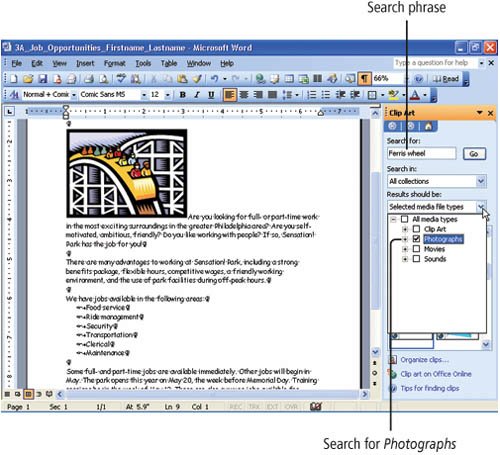
 . Display the Footer area. On the Header and Footer toolbar, click the Insert AutoText button
. Display the Footer area. On the Header and Footer toolbar, click the Insert AutoText button  , and then click Filename.
, and then click Filename. the Header and Footer toolbar and Save
the Header and Footer toolbar and Save  to restore the image to its original size. Point to the sizing handle on the lower right corner of the image to display the Diagonal Resize pointer
to restore the image to its original size. Point to the sizing handle on the lower right corner of the image to display the Diagonal Resize pointer  and drag up and to the left until the image is about one inch high. Compare your screen with Figure 3.13.
and drag up and to the left until the image is about one inch high. Compare your screen with Figure 3.13. attached to the pointer, as shown in Figure 3.14.
attached to the pointer, as shown in Figure 3.14. and press any of the directional arrow keys on your keyboard to drive the image in any direction so that the text wraps as shown in Figure 3.15.
and press any of the directional arrow keys on your keyboard to drive the image in any direction so that the text wraps as shown in Figure 3.15.